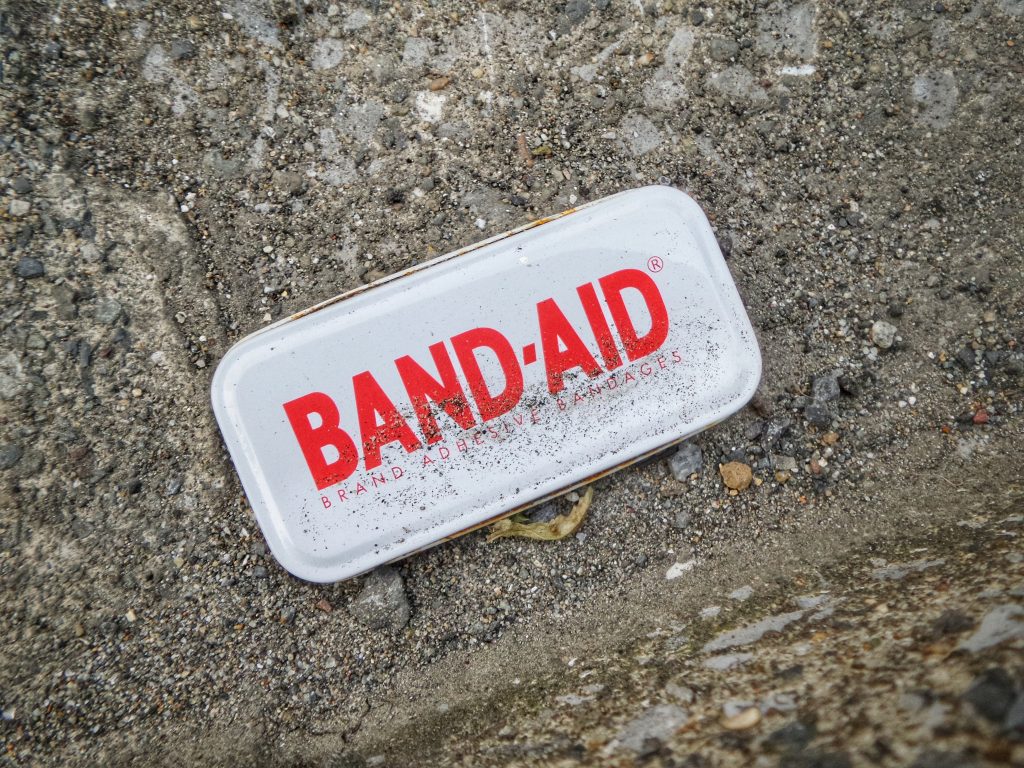
Learn How to Save a Painting That Seems Unfixable
If you’ve been doing art for any length of time, you may have the same problem I do.
Half-finished artworks.
Abandoned canvases.
Paintings you faced to the wall because you don’t want to look at them.
Why?
Well, let’s be honest – they kinda suck.
Why We Leave Art Unfinished
Maybe you were just experimenting. Or you had an idea that you didn’t know how to finish. A few times, a better idea came along – you started a new canvas and went with that idea instead. (Not shiny object syndrome, of course not!)
We all do it.
Not every piece of art we start will be a masterpiece. And while there’s nothing wrong with this (nothing wrong at all!) eventually we have a pile of abandoned and half-finished canvases just sitting there, gathering dust. We tell ourselves someday we will get back to them.
But here’s the honest truth: sometimes you don’t need to get back to a particular piece. Whatever it is you needed to practice, learn, or experiment with was completed and you didn’t need to finish the art to accomplish that.
Maybe you got halfway through and realized the idea wasn’t very good. Or the composition was wrong, or you didn’t have the particular skill you needed yet. Or any number of other reasons! They’re all valid, and they all taught you something.
But now there’s the fact that you have these unfinished pieces taking up space and adding to your “mental” clutter.
So, what to do?
Be a hero – save a painting!
My best advice would be to gain something useful out of your abandoned pieces. After all, here is a canvas just sitting there – one you don’t have to go out and buy. Might as well make use of it, right?
If you find yourself in this situation, where you’re holding on to abandoned art pieces and would like to (finally, in my case) deal with them, you have two options. (This is where this post turns into one of those Choose-Your-Adventure stories! Remember those? Which one will you choose . . .?)
- Find a way to save a painting by finishing the piece (or at least use parts of it to make a finished piece).
- Get the canvas back to a blank slate so you can start over.
So let’s take a look at how to turn that abandoned art into something useful!
Option #1: Finish the artwork
Depending on the artwork, this could be a good option. If you still love the idea or concept you were starting from, the decision to save a painting is logical. The only thing you need to figure out is why you stopped working on the piece. Some common reasons:
- Ran out of time or forgot about it
- You were working out an idea and weren’t sure how to complete it
- A particular skill was lacking and you didn’t have it at the time
- You were working with a new medium or art supply and it didn’t go as expected
- Something about the piece was “off” but you weren’t sure what (Composition/color/accuracy are common answers here)
Let’s look at these reasons a little more closely.
Forgotten. Obviously, for the first option – if time or forgetting was the reason – it should be fairly easy to pick back up working on the piece. For the rest, you may need to think or do some research before you can continue.
Doesn’t Work. Sometimes it’s the idea of the painting itself that isn’t working. It can feel like one part of the painting is speaking English while another part is trying to speak French. It doesn’t make sense to look at it. You need to decide which part makes the most sense and remove or replace the parts that don’t in order to save a painting that doesn’t work. It’s like an art version of that Sesame Street game . . . one of these things is not like the other, one of these things is not quite the same.
Lack of Skill. If you were missing a skill, ask yourself if you have learned that now? Or is there someone you know who could help you learn it?
Unfamiliar Supplies. Do you understand the new art supply better now? Or – maybe you can keep going with the artwork using a more familiar supply. (Remember, depending on what is underneath you have to be careful what you put on top. If you were working with oils, you probably need to keep going with the oil or remove the oil and re-gesso. If you were using watercolor, acrylic, gouache, or inks, you are pretty safe to layer other mediums on top).
Something’s Off. If it was the last option – something was “off”- you need to take the time to figure out what it was and if you are able to correct it. It could be a simple thing – the eyes in your portrait are the wrong size so you just need to make them bigger or smaller. Or it could be something that takes more effort, such as the background being too distracting and taking away from the painting’s subject. In that case, you would need to find a way to tone down the background and make the painting’s subject the star again.
Once you know why you abandoned a piece of art and how to fix the problem you were having, finishing it becomes much easier!
Option #2: Start over with a blank canvas
Sadly, sometimes you just need to cut your losses and admit a painting would be best served by starting over completely!
Depending on how much you liked a particular painting, this can be an easy decision or a heart wrenching one. But if you’ve done art long enough, you’re going to eventually come across a painting that is just never going to happen. (in that particular form, anyway). The reasons for this vary:
- You aren’t excited about that idea anymore
- You did something similar in another painting and liked it more
- There are a lot of technical flaws to fix
- You get the “wrong” feeling from the painting
If you decide to save a painting by starting over, you have to decide if you’re going to “go back to the canvas” or cover what’s there and start your new painting on top.
Obviously, depending what’s already on the canvas, this may take a little work. If you want to go back to canvas, you may need to remove what’s there with soap and water, turpentine or another solvent, rubbing alcohol, a scraper or X-acto knife, or sandpaper. Once you’ve removed as much as you can, you can go ahead and gesso and then voila! You have a “brand new” canvas.
Helpful Hint: If your painting was done in oils, you will want to remove the oil paint as completely as possible. This article on ehow.com explains how to safely and correctly remove oil paint.
If you do heavily textured mixed media works, this might present a bit of a challenge. This might be when you decide to paint or create on top of what’s already there. Maybe you just have color and glued mixed media paper and items to start with. These can easily be recolored or have more items layered on top.
You could also paint a layer of white (or black or grey) gesso or acrylic over what’s there and then add more texture and/or paint so it pulls all the layers together. You could turn a heavily textured artwork into more of an abstract piece and maybe add some words, stencils, ink, or stamping over your new layers.
Examples From My Own Art
Below are a few paintings I had abandoned or started over. Some I kept the original idea, and some I did a completely new thing.
Girl with Curly Hair Painting

For this painting, I originally created a background and then painted a portrait in acrylics. But after I let it sit, something about the face bothered me. The angle and proportions were off. So I painted over the acrylic with white gesso, drew an updated version of the portrait, and painted her in oils this time.
Painting saved!

Yellow Background Painting
I absolutely loved the background of this painting. But I felt like I could never do a good enough subject to go with it! I tried several times to redo the portrait, but it never worked and I was very frustrated. It sat for a long time unfinished, but I kept thinking about it because of that dang background. Finally, I realized it needed a different subject in order to work.

I had done the portrait in oils (boo!) so I had to scrape and use turpentine to wipe the paint away. Then I did a layer of white gesso and drew a new portrait. I finally feel like the subject and background of this painting match!

Queen Painting
The background and drawing the portrait here went quickly . . . and then something happened. I kept painting the face over and over, and I could never get it to look right! This is one where I started over completely from a blank white canvas because I couldn’t figure out how to save her as she was.

I’m so glad I decided to start her over because I think the finished painting (below) is a much better painting.

Abstract Background
This painting (the yellow one in the photo below) sat in my closet for more than a year after I started it, just gathering dust. Finally I pulled it out along with several others.

Since it already had mixed media items on it, I knew it would be hard to try to take stuff off. So instead, I added a lot more pieces to it, and layered more color on. A theme emerged and suddenly I was feeling the “Beachy Vibes!”

As you can see from the examples from my own work, nothing is ever really lost. My art mentor likes to tell us, “everything is fixable . . . there are no mistakes.” Paintings are forgiving. Even Bob Ross loved to say “there are no mistakes, just happy accidents.” With time and patience, and the willingness to think about your art, you really can save a painting -any painting!- and turn it into something you love and are proud of.

I’d love to hear from you! Have you ever tried to save a painting you abandoned or gave up on? Did the new painting work better? Have you ever said “the heck with it!” and started over completely? Leave me your comments below!
Interested in more mixed media art tips and tricks? Check out my article on My 10 Favorite Mixed Media Art Supplies

- Art That Heals: The Mental Magic of Mixed Media - August 20, 2024
- The Fundamentals of Mixed Media Art: How to Create Art That Inspires - August 14, 2024
- From Chaos to Creation: 3 Experimental Mixed Media Painting Techniques to Try - June 24, 2024

